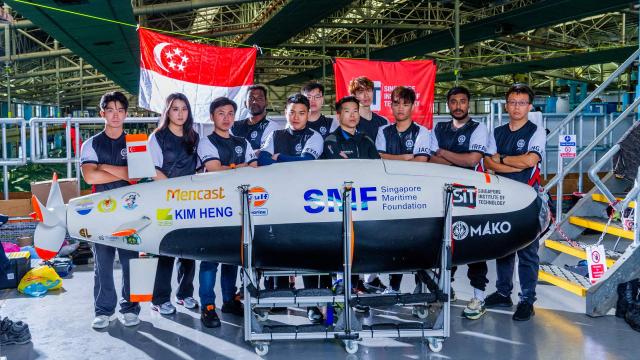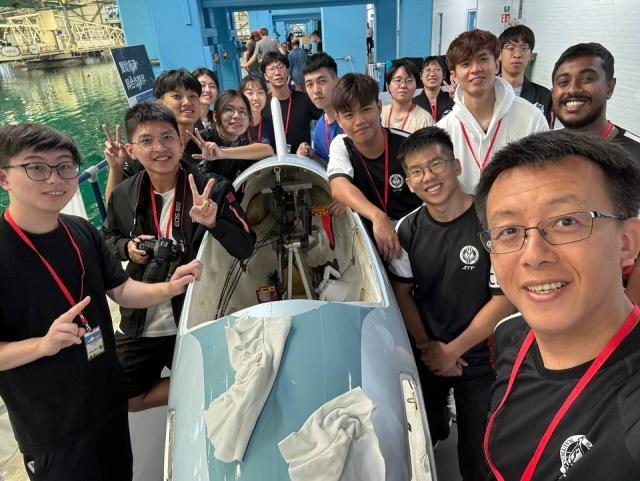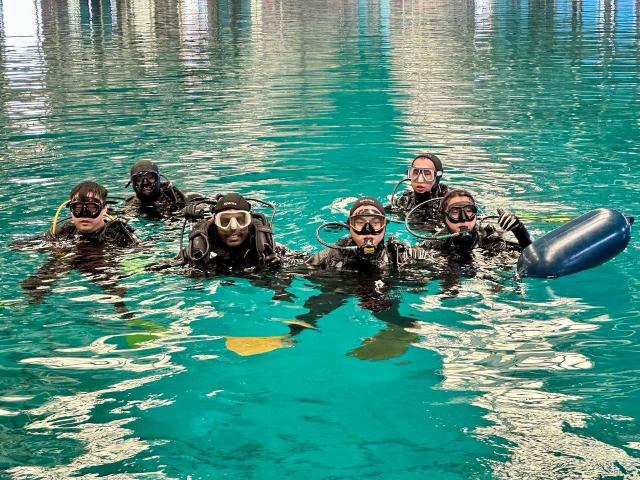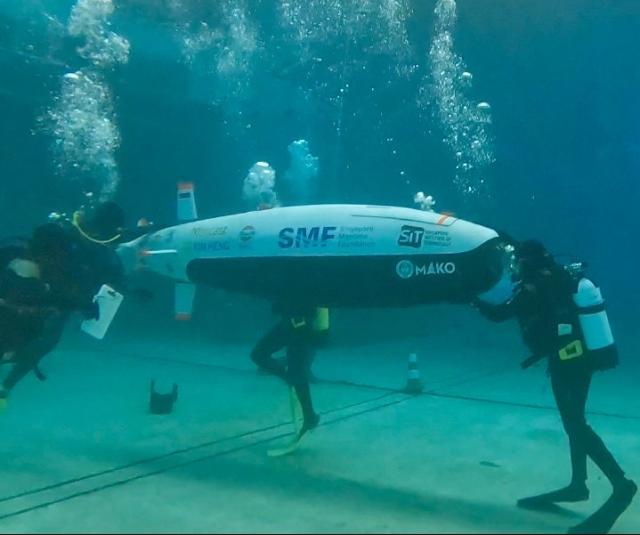Team SIT flew the Singapore flag high at the European International SubRace 2024 by winning the Best Newcomer Award.
Making waves in the world of submarine engineering, SIT Nautical Knights broke new ground as the first Southeast Asian team to dive into the European International SubRace 2024. Hosted by defence technology company QinetiQ and the Institute of Marine Engineering, Science & Technology (IMarEST), this prestigious biennial competition challenges the limits of human-powered submarine design. This year’s thrilling race, held in Gosport, UK, from 24 June to 5 July, saw the 10-member student squad from SIT achieve a fourth-place finish among 11 international teams, while also securing the Best Newcomer Award.

SIT Nautical Knights with their human-powered submarine at the QinetiQ Ocean Basin facility in the UK. (Photo: James Sheppard)
A Fortnight of Competition
Led by Associate Professor Wang Xin, Programme Leader of the Naval Architecture and Marine Engineering (NAME) programme, SIT Nautical Knights embarked on a two-week odyssey in the UK. The team comprises Year 2 and Year 3 undergraduates from NAME and Marine Engineering, Naval Architecture and Offshore Engineering programmes.
The first week was a whirlwind of activity as the team prepared their submarine for the race. “The QinetiQ Ocean Basin is an impressive facility – imagine a football field submerged six metres under water! It's the perfect stage for such a unique competition. When we finally unboxed our submarine from its crate, it was a truly rewarding moment after months of hard work and preparation,” shared A/Prof Wang.

A/Prof Wang Xin (front row, extreme right) with members of SIT Nautical Knights and Taiwanese participants from National Cheng Kung University. (Photo: SIT Nautical Knights)
SIT Nautical Knights’ human-powered submarine, named ‘MAKO’, is the result of eight months of meticulous design and engineering. The team prioritised speed and manoeuvrability, which are essential for navigating the challenging racecourse. To achieve this, they adopted a conservative yet effective approach, focusing on a classic single-screw propeller. Team Captain Ryan Tan, a Year 3 Offshore Engineering undergraduate, shared, “We learned how to build the submarine with fibreglass from scratch, gaining skill and experience during the process.”
Roles within the team were purposefully assigned, with members taking on various responsibilities such as diving, piloting, fabrication, propulsion, controls, hull design, logistics, safety, and team management. The students were mentored by A/Prof Wang and benefitted from the guidance of A/Prof Eugene Wong, Director of Programmes for the Engineering Cluster.
Submarines: One Size Doesn’t Fit All
“It was incredible to see the diverse showcase of human-powered submarine designs from seasoned teams like the US, Canada, Germany and Taiwan. Being able to observe the submarines up close was eye-opening,” added Ryan.
Measuring 3.6 metres long and weighing 120kg, MAKO was a strong contender. Year 2 NAME student Muhammad Irfaanali Bin Jahir Hussain, the pilot assistant and a fabrication team member, said, “The other international teams took notice of our submarine and saw the potential in our design, which was exciting given it was our first foray into the competition! We felt confident we were in the running.”

Our student divers endured waters with a temperature as low as 15 degree Celsius. (Photo: SIT Nautical Knights)
Underwater Obstacles
It wasn't all smooth sailing though. During preparation week, the team faced a major challenge when the safety buoy malfunctioned during the first wet test. Undeterred, they spent a gruelling six hours in the chilling 15 degree Celsius waters to rectify the issue. “Additionally, the adhesive holding the shaft collar to our submarine hull wore off at various points during the competition. We were grateful to receive help from other teams to rectify the issue,” added Irfaanali. “It was a testament to the spirit of collaboration that existed among all participants, despite being competitors.” Beyond the competition, the team had opportunities to network with other teams through social events such as Fourth of July festivities and barbecues.
Race day brought a mix of excitement and nerves. One of the greatest challenges was in the last section of the racecourse, featuring a slalom course with four poles set 13 metres apart, testing the submarine’s agility. The submarine must weave through the slalom course in an alternating pattern, passing the first and third poles on the right, and the second and fourth poles on the left. In addition to race position, teams were judged on performance, reliability, design report, dry inspection, and wet check.
A scare occurred in the first run when the pilot hatch unexpectedly opened. The team took another hit in the second run when their submarine unexpectedly surfaced and the run had to be aborted. But the team took these in their stride. A/Prof Wang shared, “It was all part of the learning curve as our pilot, Year 2 NAME student Chester Toh, adapted to the unique sensations of underwater navigation.” The team rebounded with a surprising team record, achieving a top speed of 2.69 knots and their fastest lap at 2 minutes and 37 seconds – resulting in an overall fourth-place finish. Clinching the top spot was Team Omer from École de technologie supérieure, Canada.

Student divers played an important role in helping the submarine pilot navigate the racecourse. (Photo: SIT Nautical Knights)
A Tapestry of Teamwork and Friendship
Beyond the competition, the team's journey in the UK was marked by a sense of camaraderie. Sharing a living space forged deep connections amongst team members as they took turns to cook and complete house chores, and even enjoyed recreational activities like table tennis, go-karting, and friendly FIFA PlayStation matches with A/Prof Wang. “Through these shared experiences, we learned more about one another and discovered a playful side to our professor that we hadn't seen before,” shared Irfaanali.
SIT Nautical Knights’ debut performance marks the beginning of an exciting new chapter. The team is looking ahead to future opportunities, including potentially participating in the American edition of the races in 2025. "Our participation in the European International SubRace 2024 was a collective effort by both students and faculty and serves as a prime example of a practical learning experience for students. This aligns perfectly with SIT's applied learning pedagogy. I encourage students to seek opportunities for such outside-classroom experiences," shared A/Prof Wang.
SIT Nautical Knights would like to thank the following individuals for their invaluable contributions to the team's success:
- Associate Professor Mark Teo Ching Leong, Engineering Cluster
- Associate Professor Caesar Jung-Harada, Business, Communication and Design Cluster
- Associate Professor Choo Jian Huei, Engineering Cluster
- Mr Jeffrey Julian Matius, SIT Teaching and Learning Academy
- Mr Michael Pilgaard Nielsen, Lead Professional Officer, Professional Officers Division
- Ms Cherine Ng Siew Eng, Lead Professional Officer, Professional Officers Division
- Mr Lim Yau Shiang, Senior Professional Officer, Professional Officers Division
- Mr Hui Yijian, Research Engineer, NAMIC@SIT
- Mr Koh Kok Hui, Hospitality Business undergraduate
- Ms Tharani Gunalan, Chemical Engineering undergraduate















![[FA] SIT One SITizen Alumni Initiative_Web banner_1244px x 688px.jpg](/sites/default/files/2024-12/%5BFA%5D%20%20SIT%20One%20SITizen%20Alumni%20Initiative_Web%20banner_1244px%20x%20688px.jpg)


